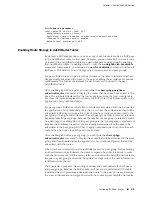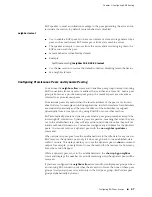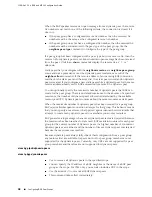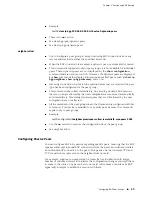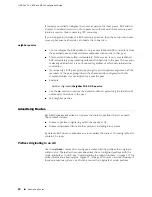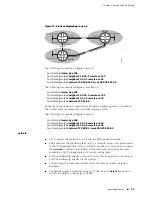
host1:3#
show ip bgp fields intro best peer loc-pref as-path
Local router ID 13.13.13.3, local AS 200
10 paths, 5 distinct prefixes (520 bytes used)
6 paths selected for route table installation
14 path attribute entries (1943 bytes used)
Status codes: > best
Prefix Peer LocPrf AS-path
10.23.40.1/32 192.168.13.1 200 100 211 32 15 67 44 (too long)
> 10.23.40.1/32 172.123.23.2 100 100 211
> 10.23.40.2/32 192.168.13.1 200 100 211 32 15 67
10.23.40.2/32 172.123.23.2 100 100 211 32
> 10.23.40.3/32 192.168.13.1 100 211 32 15
10.23.40.3/32 172.123.23.2 100 211 32 15
10.23.40.4/32 192.168.13.1 100 100 211 32
> 10.23.40.4/32 172.123.23.2 200 100 211 32 15 67
> 10.23.40.5/32 192.168.13.1 100 100 211
10.23.40.5/32 172.123.23.2 200 100 211 32 15 67 44 (too long)
Enabling MD5 Authentication on a TCP Connection
You can use the
neighbor password
command to enable MD5 authentication on a
TCP connection between two BGP peers. Enabling MD5 authentication causes each
segment sent on the TCP connection between them to be verified.
You must configure MD5 authentication with the same password on both BGP peers;
otherwise, the router does not make the connection between the BGP peers.
The MD5 authentication feature uses the MD5 algorithm. When you specify this
command, the router generates and checks the MD5 digest on every segment sent
on the TCP connection.
In the following example, the password is set to “ opensesame” :
host1(config)#
router bgp 100
host1(config-router)#
neighbor 2.2.2.2 password opensesame
The
show ip bgp neighbors
command does not reveal the password, but does indicate
whether MD5 authentication is configured for the session. The output of the
show
configuration
command varies as follows:
■
If you use the
8
keyword to specify that the password is encrypted, then the
output of the
show configuration
command displays the text that you entered
(the ciphertext password).
■
If you do not use the
8
keyword (that is, you use the
0
keyword or no encryption
keyword), and if the
service password-encryption
command has not been
issued, then the output of the
show configuration
command displays the text
that you entered (the plaintext password).
■
If you do not use the
8
keyword (that is, you use the
0
keyword or no encryption
keyword) but the
service password-encryption
command has been issued, then
the output of the
show configuration
command displays an encrypted password
that is equivalent to the cleartext password that you entered.
neighbor password
36
■
Configuring BGP Peer Groups
JUNOSe 11.1.x BGP and MPLS Configuration Guide
Summary of Contents for BGP
Page 6: ...vi ...
Page 8: ...viii JUNOSe 11 1 x BGP and MPLS Configuration Guide ...
Page 37: ...Part 1 Border Gateway Protocol Configuring BGP Routing on page 3 Border Gateway Protocol 1 ...
Page 38: ...2 Border Gateway Protocol JUNOSe 11 1 x BGP and MPLS Configuration Guide ...
Page 234: ...198 Monitoring BGP JUNOSe 11 1 x BGP and MPLS Configuration Guide ...
Page 236: ...200 Multiprotocol Layer Switching JUNOSe 11 1 x BGP and MPLS Configuration Guide ...
Page 542: ...506 Monitoring BGP MPLS VPNs JUNOSe 11 1 x BGP and MPLS Configuration Guide ...
Page 544: ...508 Layer 2 Services Over MPLS JUNOSe 11 1 x BGP and MPLS Configuration Guide ...
Page 610: ...574 Virtual Private LAN Service JUNOSe 11 1 x BGP and MPLS Configuration Guide ...
Page 624: ...588 VPLS References JUNOSe 11 1 x BGP and MPLS Configuration Guide ...
Page 680: ...644 Virtual Private Wire Service JUNOSe 11 1 x BGP and MPLS Configuration Guide ...
Page 724: ...688 Monitoring MPLS Forwarding Table for VPWS JUNOSe 11 1 x BGP and MPLS Configuration Guide ...
Page 725: ...Part 6 Index Index on page 691 Index 689 ...
Page 726: ...690 Index JUNOSe 11 1 x BGP and MPLS Configuration Guide ...




















